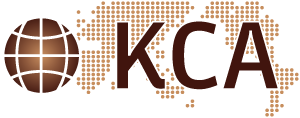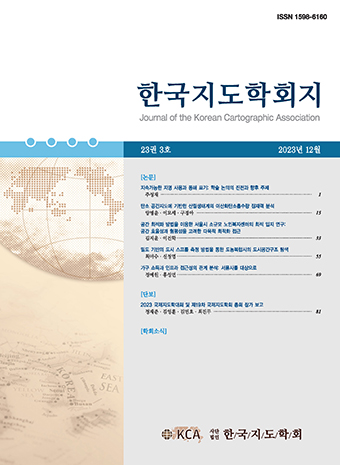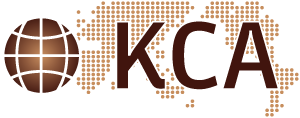Research Article
Abstract
References
Information
Cancer has long been the leading cause of death for Koreans, mainly due to environmental factors. Despite the high mortality caused by cancer, Korean studies on how geographical and environmental factors affect cancer are insufficient. The purpose of this study is to understand how the incidence of major cancers including thyroid, colorectal, stomach, lung, liver, prostate, and breast cancers differs according to geographical and environmental factors from a spatial perspective. For this purpose, Cancer incidence calculated at the si-gun-gu level was used as dependent variables, and 13 variables that were expected to affect cancer development were selected as independent variables. Global and local Moran's I statistics were used to identify spatial dependency and clustering of the dependent variables. OLS and spatial regression models were used to identify factors that affect cancer development. Global Moran’s I statistics and LISA cluster maps show spatial autocorrelation in spatial patterns of cancer development. The OLS regression analysis was performed to identify variables affecting cancer development. Since age effect was strong in most cancers, it was controlled. After confirming that spatial dependence is clearly shown in the residuals of OLS model, spatial regression analyses were performed to model spatial dependency. The results showed that the spatial regression models are suitable for explaining the incidence for all types of cancer. In particular, considering the spatial dependency, it was confirmed that factors affecting cancers may be different from those of OLS regression analysis. The results of this study showed that spatial statistical analysis can more accurately identify geographical and environmental factors affecting cancer development. These findings provide useful information on how to improve local environments to prevent cancer.
암은 오랫동안 한국인의 주된 사망원인이었으며, 주로 환경적 요인이 암 발생에 영향을 주고 있다. 암으로 인한 높은 사망률에도 불구하고, 어떠한 지리적 및 환경적 요인이 암 발생에 영향을 주는지에 대한 국내 사례 연구는 부족한 실정이다. 본 연구의 목적은 공간적 관점에서 갑상선암, 대장암, 위암, 폐암, 간암, 전립선암, 유방암을 포함한 주요 암의 발생률이 지리・환경적 요인에 따라 어떻게 다르게 나타나는지를 파악하는 것이다. 이를 위하여, 시군구 수준에서 계산된 암 발생률을 종속변수로 활용하였고, 암 발병에 영향을 미칠 것으로 기대되는 13가지 독립변수를 선정하였다. 종속변수의 공간적 의존성 및 군집을 확인하기 위하여 전역적, 국지적 Moran’s I 통계량을 이용하였고, 암 발병에 영향을 미치는 요인을 파악하기 위하여 OLS 및 공간회귀모형들을 활용하였다. 전역적 Moran 통계량과 LISA Cluster map을 통하여 암 발생의 공간적 패턴에서 공간적 자기상관을 확인할 수 있었다. 다음 OLS 회귀 분석을 통하여 암 발생에 영향을 미치는 변수들을 파악하였다. 이때 대부분의 암에서 연령 효과가 강하게 나타났기 때문에 이를 통제하였다. OLS 모형의 잔차에서 공간적 의존성이 명확하게 나타남을 확인 한 후, 공간적 의존성을 모형화하기 위하여 공간회귀분석을 수행하였다. 분석 결과 모든 유형 별 암에 대한 발생률을 설명하는데 있어 공간회귀분석이 적합한 것으로 나타났다. 특히 공간적 의존성을 고려할 경우 암별로 영향을 주는 요인이 OLS 분석 결과와 상이할 수 있음을 확인하였다. 본 연구 결과는 공간통계분석을 통하여 암 발생에 영향을 주는 지리 환경적 요인을 보다 정확하게 식별할 수 있음을 보여주었다. 이러한 결과는 암을 예방하기 위하여 지역의 환경을 요인을 어떻게 개선할 것인지에 대한 유용한 정보를 제공한다.
- 강미란, 2017, “대전・충남지역 여성 유방암 발생과 사망 추이,” 충남대학교 석사학위논문.
- 고영규, 2016, “공간 다수준 분석을 이용한 부산지역 암 발생 및 암사망 추정,” 부경대학교 석사학위논문.
- 국립암센터, 2018, 「국민 암 예방 수칙 실천지침」.
- 김광구, 2003, “공간자기상관의 탐색과 공간회구분석의 활용,” 한국행정학회 학술대회 발표논문집, 989-1001.
- 김동진・이소영・기명・김명희・김승섭・김유미・윤태호・장숙랑・정최경희・채희란・이정아, 2013, 「한국의 건강불평등 지표와 정책과제」, 서울: 한국보건사회연구원.
- 김소민, 2017, “부산지역의 박탈지수와 암 진단 건수와의 관련성 분석: 6대 암을 중심으로,” 계명대학교 석사학위논문.
- 김영애, 2014 “암 환자의 거주 지역과 의료서비스 이용 지역의 차이가 생존률에 미치는 영향,” 고려대학교 박사학위논문.
- 보건복지부・중암암등록본부, 2016, “우리나라 최초, 시군구별 암 발생통계 및 발생지도 발표,” 보도자료.
- 보건복지부・중앙암등록본부・국립암센터, 2017, 「2015년 국가암등록통계 참고 자료」.
- 성광모, 2008, “지역에 따른 대기오염 배출량과 암 발생의 연관성,” 아주대학교 석사학위논문.
- 송하나, 2014, “인구 기반의 지역별 암 발생률 비교,” 경상대학교 박사학위논문.
- 유상현, 2001, “음주와 사망 및 암 발생과의 관련성에 관한 연구,” 연세대학교 박사학위논문.
- 이건학・김감영, 2016, “공간통계 기법을 이용한 현주인구 추정 모델링,” 한국지도학회지, 16(2), 71-93.
- 이서윤, 2015, “지역별 특성이 회피가능한 암 사망에 미치는 영향,” 연세대학교 석사학위논문.
- 이석호, 2019, “공간통계기법을 이용한 암 발생율과 지리・환경적 특성과의 연관성 분석,” 경북대학교 석사학위논문.
- 이희연・노승철, 2017, 「고급통계분석론」, 제2판, 고양: 문우사.
- 임소라, 2015, “전립선암 발생률 추정과 관련 요인 분석: The Korean Cancer Prevention Study-II (KCPS-II),” 연세대학교 석사학위논문.
- 정귀준, 2017, “우리나라 폐암 발생률의 공간적 특성에 관한 연구 : 공간적 자기상관성을 중심으로,” 강원대학교 박사학위논문.
- 조하나, 2018, “질병의 지리적 분포 파악을 위한 공간 통계 기법의 비교,” 연세대학교 석사학위논문.
- 통계청, 2018, 「2017년 사망원인통계」.
- Al-Ahmadi, K. and Al-Zahrani, A., 2013, Spatial autocorrelation of cancer incidence in Saudi Arabia, International Journal of Environmental Research and Public Health, 10(12), 7207-7228.10.3390/ijerph10127207<24351742PMC3881162
- Anselin, L., 1995, Local Indicators of Spatial Association - LISA, Geographical Analysis, 27(2), 93-115.10.1111/j.1538-4632.1995.tb00338.x
- Blot, W.J., Fraumeni Jr, J.F., and Stone, B.J., 1978, Geographic correlates of pancreas cancer in the United States, Cancer, 42(1), 373-380.10.1002/1097-0142(197807)42:1<373::AID-CNCR2820420156>3.0.CO;2-L
- Geary, R.C., 1954, The contiguity ratio and statistical mapping, The Incorporated Statistician, 5, 115-145.10.2307/2986645
- Gilbert, A. and Chakraborty, J., 2011, Using geographically weighted regression for environmental justice analysis: Cumulative cancer risks from air toxics in Florida, Social Science Research, 40(1), 273-286.10.1016/j.ssresearch.2010.08.006
- Glick, B., 1979, The spatial autocorrelation of cancer mortality, Social Science & Medicine, Part D: Medical Geography, 13(2), 123-130.10.1016/0160-8002(79)90058-3
- Grant, W.B., 2003, Ecologic studies of solar UV-B radiation and cancer mortality rates, in Vitamin D, Analogs in Cancer Prevention and Therapy, Berlin, Heidelberg: Springer, 371-377.10.1007/978-3-642-55580-0_2712899536
- Moran, P., 1950, Notes on Continuous Stochastic Phenomena, Biometrika, 37, 17-33.10.2307/233214215420245
- Rosenberg, M.S., Sokal, R.R., Oden, N.L., and DiGiovanni, D., 1999, Spatial autocorrelation of cancer in Western Europe, European Journal of Epidemiology, 15(1), 15-22.10.1023/A:100755972884810098991
- Stewart, B.W. and Kleihues, P. eds., 2003, World Cancer Report, Lyon: IARCPress.
- Publisher :The Korean Cartographic Association
- Publisher(Ko) :한국지도학회
- Journal Title :Journal of the Korean Cartographic Association
- Journal Title(Ko) :한국지도학회지
- Volume : 19
- No :3
- Pages :57~74
- DOI :https://doi.org/10.16879/jkca.2019.19.3.057



 Journal of the Korean Cartographic Association
Journal of the Korean Cartographic Association





